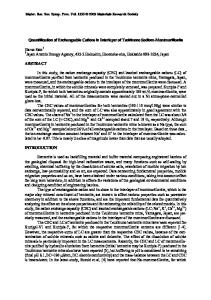Validation of a Fast Sample Preparation Procedure for Quantification of Sodium in Bread by Flame Photometry
- PDF / 111,267 Bytes
- 5 Pages / 595.276 x 790.866 pts Page_size
- 43 Downloads / 311 Views
Validation of a Fast Sample Preparation Procedure for Quantification of Sodium in Bread by Flame Photometry Elsa Vieira & M. Elisa Soares & Isabel M. P. L. V. O. Ferreira & Olívia Pinho
Received: 28 January 2011 / Accepted: 5 May 2011 / Published online: 22 June 2011 # Springer Science+Business Media, LLC 2011
Abstract Reduction of salt intake through bread requires reliable monitorization when the control of a large number of samples is in order. The use of flame photometry is attractive; however, the usual dry-ash sample pretreatment is fastidious. Direct dissolution of bread sodium in water is a good alternative. A good correlation between results from these two sample preparation methods was obtained for sodium quantification in nine different types of bread. The proposed method was applied to the quantification of sodium in 48 bread samples of randomly chosen from local market to evaluate compliance with legislation requirements (lower than 550 mg sodium per 100 g of bread—Lei no. 75/2009). Keywords Bread . Sodium . Salt restriction . Hypertension . Flame photometry . Validation
E. Vieira : O. Pinho Faculdade de Ciências da Nutrição e Alimentação da Universidade do Porto, Rua Dr. Roberto Frias, 4200-465 Porto, Portugal M. E. Soares REQUIMTE- Serviço de Toxicologia, Faculdade de Farmácia da Universidade do Porto, Rua Aníbal Cunha 164, 4099-030 Porto, Portugal I. M. P. L. V. O. Ferreira : O. Pinho (*) REQUIMTE- Serviço de Bromatologia, Faculdade de Farmácia da Universidade do Porto, Rua Aníbal Cunha 164, 4099-030 Porto, Portugal e-mail: [email protected]
Introduction Bread is an inexpensive source of energy: it contains carbohydrates, lipids, and proteins, and it is important as a source of essential vitamins of the B complex and of vitamin E, minerals, and trace elements (Fernández 2003). Salt is added to bread to provide flavor and increase shelf life, and because of its effect on the breadmaking process. Salt has an influence on the rheological properties of dough: it inhibits the hydration of gluten; the gluten shrinks, the dough does not collapse, and gas retention is improved. Higher concentrations of salt inhibit enzymatic reactions and also inhibit the fermentation activity of yeast. In general, the proportion of salt used is 1–2% (Fernández 2003). Thus, the salt content present in bread is of great concerns for food processing (Chen et al. 2005). Food and Nutrition Board has set an estimated minimum requirement for healthy person for the three minerals (sodium, chloride, and potassium) that are major electrolytes in body fluids. The Estimated Minimum Requirement for sodium is 500 mg/day for healthy person over age 18. The body can adjust to a rather wide range of dietary sodium by mechanism designer to conserve or excrete this mineral. To cover wide variations in individual patterns of physical activity and climate which influence relative losses in perspiration, the Upper Limit for sodium in adults has been set at 2,400 mg/day or less. Higher intakes carry no health benefits and may actually be
Data Loading...











